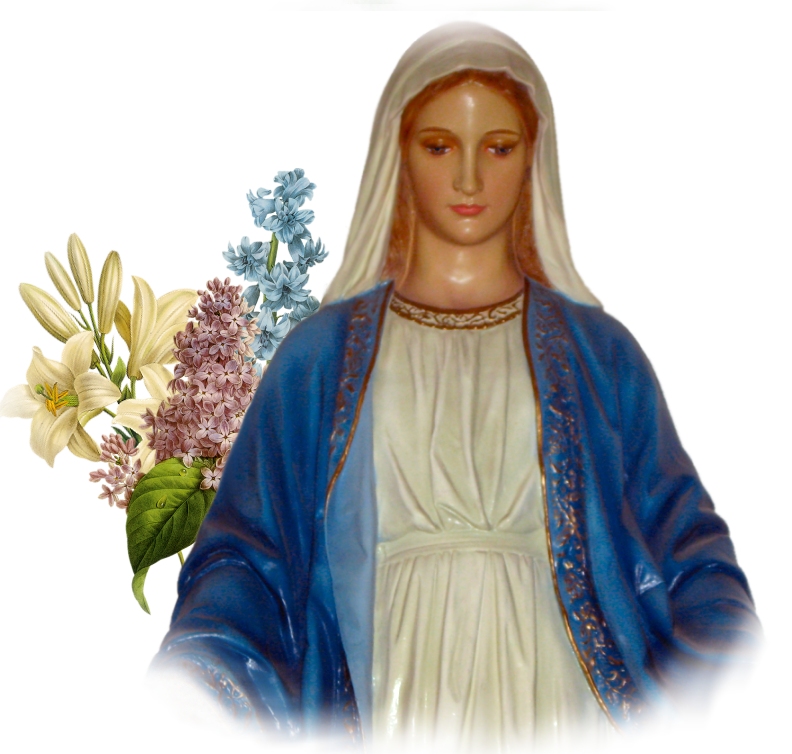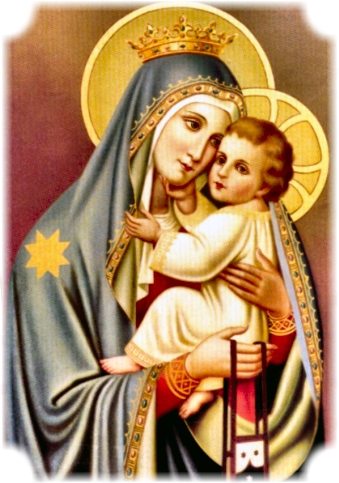

by St. Alphonsus Liguori,
Doctor of the Church
TAKEN FROM THE GLORIES OF MARY
Eccles. Approval, 1852
FOURTH DEVOTION
Of Fasting
There are many devout clients of Mary who, to honor her, fast on bread and water on Saturdays, and the vigils of her feasts. It is well known that Saturday is dedicated by the holy Church to Mary, because, as Saint Bernard says, on that day, the day after the
death of her Son, she remained constant in faith. Therefore Mary's clients are careful to honor her on that day by some particular devotion, and especially by fasting on bread and water, as did Saint Charles Borromeo, Cardinal Tolet, and so many others. Nitardo, Bishop of Bamberg, and Father Joseph Arriaga, of the Society of Jesus, took no food at all on that day. The great graces which the Mother of God has dispensed to those who do this are recorded by Father Auriemma in his little work. Let one example suffice: it is that of a famous captain of brigands, who, on account of this devotion, was preserved in life after his head was cut off, and was thus enabled to make his confession; for the unfortunate creature was in a state of sin. After confession he declared that, on account of this devotion, the Blessed Virgin had obtained him so great a grace, and immediately expired. It would not, then, be anything very great, for a person who pretends to be devout to Mary, and particularly for one who has perhaps already deserved Hell, to offer her this fast on Saturdays. I affirm that those who practice this devotion can hardly be lost; not that I mean to say that if they die in mortal sin the Blessed Virgin will deliver them by a miracle, as she did this bandit: these are prodigies of Divine mercy which very rarely occur, and it would be the height of folly to expect eternal salvation by such means; but I say, that for those who practice this devotion, the Divine Mother will make perseverance in God's grace easy, and obtain them a good death. All the members of our little congregation, who are able to do so, practice this devotion. I say those who are able to do so; for if our health does not permit it, at least we should on Saturdays content ourselves with one dish, or observe an ordinary fast, or abstain from fruit, or something for which we have a relish. On Saturdays we should always practice some devotion in honor of our Blessed Lady, receive the Holy Communion, or at least hear Mass, visit an image of Mary, wear a hair-cloth, or something of that sort. But on the vigils of her principal festivals, at all events, her clients should offer her this fast either on bread and water, or otherwise as best they can.
FIFTH DEVOTION
Of Visiting the Images of Mary
Father Segneri says, that the devil did not know how to repair his losses in the overthrow of idolatry better than by attacking sacred images through the instrumentality of heretics. But the holy Church has defended them even with the blood of Martyrs; and the Divine Mother has shown by prodigies how pleasing to her are the visits paid to her images. Saint John Damascen had his hand cut off for having defended, by his writings, the images of Mary; but his Sovereign Lady miraculously restored it to him. Father Spinelli relates, that in Constantinople, a veil which covered an image of the Blessed Virgin, on every Saturday drew itself aside, and after vespers again closed of its own accord. The veil of an image of our Blessed Lady, visited by Saint John of God, was once withdrawn in a similar manner; so much so that the sacristan thought that the Saint was a robber, and kicked him; but his foot instantly withered. Hence all Mary's clients often visit her images and the churches dedicated in her honor with great affection. These are precisely, according to Saint John Damascene, the cities of refuge in which we can find safety from temptations, and the chastisements which we have deserved for our sins. The first thing that the Emperor Saint Henry used to do, on entering a city, was to visit a church of our Blessed Lady. Father Thomas Sanchez used never to return home without having visited some church of Mary. Let us not think it too much to visit our Queen every day in some church or chapel, or even in our own house, where for this purpose it would be well to have in a retired part a little oratory, with her image, which should be kept decorated with drapery, flowers, tapers, or lamps; and before it we should also recite her litany, the Rosary, etc. For this purpose I have published a little book (which has already been reprinted eight times, of visits to the Blessed Sacrament as well as to the Blessed Virgin, for every day in the month. Some devout client of Mary could also have one of her feasts celebrated in a church or chapel, with greater solemnity than it otherwise would be, and have it preceded by a novena, with exposition of the Blessed Sacrament, and even with sermons.
Here, however, it is well to relate a fact recorded by Father Spinelli, in his book of Miracles of the Madonna, number 65. In the year 1611, on the vigil of Pentecost, an immense concourse of people had assembled at the celebrated sanctuary of Mary, at Montevergine. The people had profaned the feast with dances, excess, and immodest conduct, when suddenly it was discovered that fire was bursting forth from the house of amusement in which they were assembled, and in less than an hour and a half it was reduced to ashes, and more than 1500 persons lost their lives. Five persons who escaped deposed on oath that they had seen our Blessed Lady herself set fire to the place with two torches. After this, I entreat the clients of Mary to keep away as much as possible from such places during festivals, and also, as far as they can, to prevent others from going there; for, on such occasions, the devil gains more profit than the Blessed Virgin derives honor by it. Let those who have this devotion go at a time when there's no concourse of people.

SIXTH DEVOTION
Of the Scapular
As men esteem it an honor to have persons who wear their livery, so also is our Blessed Lady pleased that her clients should wear her scapular, as a mark that they have dedicated themselves to her service, and that they are members of the household of the Mother of God. Modern heretics, as usual, ridicule this devotion; but the holy Church has approved it by many bulls and indulgences. Fathers Crasset and Lezzana, speaking of the scapular of Mount Carmel, relates, that towards the year 1251, the Blessed Virgin appeared to Saint Simon Stock, an Englishman, and giving him the scapular, said, that all who should wear it would be saved from eternal damnation. She said, "Receive, my beloved son, this scapular of thy order, the badge of my confraternity, a privilege granted to thee and to all Carmelites: whoever dies clothed with it will not suffer eternal flames." Moreover, Father Crasset relates that Mary appeared to Pope John XXII, and commanded him to make it known that all those who should wear this scapular would be delivered from Purgatory on the Saturday after their deaths; and this he did by a bull, which was afterwards confirmed by Alexander V, Clement VII, and other Pontiffs. Paul V, ... gives us to understand the same thing, and seems to explain the bulls of his predecessors, and prescribes in his the conditions on which the indulgences may be gained. These conditions are: that each one should observe the chastity required in his state of life, and the recitation of the little office of the Blessed Virgin; those who cannot do so must be exact in keeping the fast-days prescribed by the Church, and abstain from meat on Wednesdays.
The indulgences, moreover, which are annexed to this scapular of Mount Carmel, as also to those of the Seven Dolors, of our Lady of Mercy, and especially to that of her Immaculate Conception, are innumerable, as well partial as plenary, both in life and for the hour of death. For my own part, I have been careful to receive all these scapulars. To that of the Immaculate Conception in particular, very great indulgences have been attached by various sovereign Pontiffs.
 E-MAIL
E-MAIL
HOME---------------MARY'S INDEX----------------GLORIES OF MARY
www.catholictradition.org/Mary/mary23-3.htm